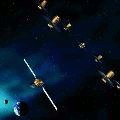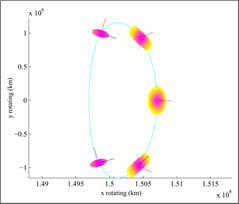Natural Formations in Astrodynamics

Multiple spacecraft in formation yield significant benefits compared to single spacecraft including a reduction of the size and weight of the spacecraft with its consequent savings in launch costs, and the possibility of a fast replacement and redundancy in case of vehicle failure. Spacecraft formations offer many potential applications in the future of space exploration, including the search for habitable terrestrial exoplanets, the identification of black holes, and many others. Multiple spacecraft in a formation yield significant benefits compared to single spacecraft including the possibility of high resolution for scientific applications, a reduction of the size and weight of the spacecraft with its consequent savings in launch costs, and the possibility of a fast replacement and redundancy in case of vehicle failure.
Most of the formation flying mission concepts typically investigate spacecraft placed on orbits around the Earth (see past project: Magic Inclinations). During the last decade, due to the detection of a large number of extrasolar planets, new studies on formation flying in multi-body regimes have emerged to support space astronomy. For example, the original New Worlds Observer (NWO) design concept employs a telescope and an external occulter for the detection and characterization of Earth-like planets. During the observation of the star, the distance between the two spacecraft and the pointing direction of the formation toward the star line-of-sight are maintained constant. The occulter suppresses the starlight by many orders of magnitude, to enable the observation of habitable terrestrial planets and the detection of life signs.
Natural Formations in Multi-body Regimes:

The L2 Sun-Earth libration point region has been a popular destination for satellite imaging formations. It is a relatively cold environment, far away from the disturbances of the Sun and therefore ideal for astronomical instruments. However, controlling multiple spacecraft in a multi-body environment is challenging and a good understanding of the natural dynamics in this regime is essential. Hence, this study explores the dynamical environment near the L2 Sun-Earth libration point to aid in the control of a formation of spacecraft, in terms of the relative distance between vehicles. Regions with low natural drift that are suitable to maintain multiple spacecraft in a loose formation are determined near the libration points orbits. Locating a formation of spacecraft in these zones leads to a smaller variation in the mutual distance between the spacecraft and the pointing direction of the formation.
Natural regions close to the given chief reference path are derived to maintain small formations of spacecraft. Ideally, regions with zero relative velocity and zero relative acceleration maintain the mutual distance between the spacecraft and the pointing direction orienting the formation. Assuming that the separation between the spacecraft is “small”, no greater than a few kilometers at most, regions of low drift are derived via first-order variational equations with respect to the given reference orbit. These regions represent quadric surfaces of two types, either ellipsoids or elliptic cylinders, and the relationship between the type of quadric surfaces and the eigenstructure of the reference trajectory is investigated. Placing the spacecraft in these regions results in a reduction in the control effort to maintain both the distance between the spacecraft and the specified formation pointing direction.
Various control strategies have been tested such as impulsive maneuvers and low-thrust controllers to maintain a two spacescraft formation during a star observation (i.e, to maintain a telescope-occulter formation fixed inertially). By placing the external occulter in these low drift regions, the control required to maintain the telescope-occulter distance, as well as the pointing direction toward a star is demonstrated to be reduced for every control strategies.